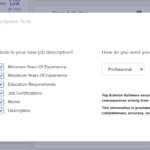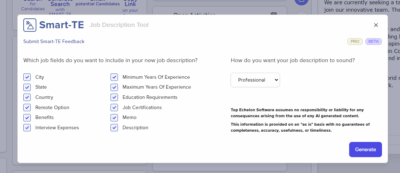In the highly competitive world of recruitment, agency recruiters and search consultants are constantly seeking new ways to identify, engage, and place top-tier talent. While active job seekers remain a crucial focus, the real goldmine for many recruiters lies in the pool of passive candidates. These are individuals who are not actively seeking a new role but are often open to the right opportunity if it presents itself. Successfully engaging and placing passive candidates can significantly boost your placement rates, help you fill more challenging roles, and differentiate your recruitment firm from the competition.
This article from Top Echelon Recruiting Software will delve into the power of passive candidates, explore why they are so valuable, and provide actionable strategies for agency recruiters and search consultants to effectively engage and place this talent.
Understanding the Value of Passive Candidates
Passive candidates are professionals who are currently employed, satisfied with their roles, and not actively seeking new opportunities. However, they can be open to considering a change if the right role or career advancement opportunity presents itself. According to LinkedIn, approximately 70% of the global workforce consists of passive talent, making it a massive and often untapped talent pool for recruiters.
Why Passive Candidates Matter:
- Higher Quality Talent: Passive candidates are often highly skilled and experienced, having already proven their capabilities in their current roles.
- Less Competition: Since passive candidates are not actively applying for jobs, there is typically less competition from other recruiters.
- Better Retention Rates: Research shows that passive candidates, once placed, tend to stay longer in their new roles because they made a more thoughtful and strategic career move.
By focusing on passive candidates, agency recruiters can access a pool of high-quality talent that is often unavailable to their competitors, allowing them to place top-tier professionals in roles that may have otherwise gone unfilled.
1. Identifying Passive Candidates: Where to Look
To effectively engage passive candidates, you first need to know where to find them. Since these individuals are not actively applying for jobs, you won’t find them on traditional job boards. Instead, you must leverage a variety of sourcing techniques to identify and connect with them.
Sources for Passive Candidates:
- LinkedIn: LinkedIn remains the number one platform for sourcing passive candidates. Advanced search functions and Boolean operators allow recruiters to identify candidates based on specific skills, industries, and job titles. Tools like LinkedIn Recruiter offer even more robust features for targeting passive talent.
- Professional Networks and Communities: Passive candidates often participate in industry-specific online forums, groups, or social media communities (e.g., GitHub for developers, Dribbble for designers, etc.). Engaging in these communities allows recruiters to build relationships and identify potential candidates over time.
- Employee Referrals: Your existing network of clients and candidates can be a powerful source of passive candidates. Strong employee referral programs encourage people to refer top talent from their own networks, many of whom may be passive candidates.
- Company Websites and Online Portfolios: Many passive candidates maintain professional websites or portfolios that showcase their skills and accomplishments. These can be excellent resources for finding high-quality talent, particularly in creative, technical, or freelance industries.
By leveraging these platforms and sources, recruiters can identify passive candidates who may be a perfect fit for a client’s open role, even if they aren’t actively looking for a new job.
2. Building Relationships with Passive Candidates
Engaging passive candidates is a more nuanced process than working with active job seekers. Since they aren’t in job-hunting mode, recruiters must focus on building long-term relationships rather than pushing for immediate placements. The key to success lies in earning their trust and staying on their radar.
Strategies for Relationship Building:
- Personalized Outreach: When reaching out to passive candidates, avoid generic messages. Instead, personalize your communication by referencing specific aspects of their background, achievements, or skills. Tailor your outreach to show that you’ve taken the time to understand their unique experience and career goals.
- Offer Value First: Passive candidates are not actively searching for new roles, so your initial contact should not be focused solely on pitching a job. Instead, provide value by offering industry insights, career advice, or information about upcoming networking events. This positions you as a resource rather than a salesperson.
- Nurture Long-Term Relationships: Engage with passive candidates over time by regularly sharing relevant content or checking in to see how their career is progressing. This consistent engagement will help you stay top-of-mind when they eventually consider a career move.
- Respect Their Time: Passive candidates are often busy professionals, so it’s important to be respectful of their time and avoid being overly aggressive in your approach. Offer flexible times for conversations and be clear about what you’re offering without overwhelming them with information.
Building trust with passive candidates is essential, as they will only consider new opportunities if they believe you have their best interests in mind.
3. Positioning Opportunities to Passive Candidates
Once you’ve established a relationship with a passive candidate, the next step is positioning the right opportunity to them. This requires a deep understanding of the candidate’s career aspirations, motivations, and current job satisfaction. You must craft your messaging to align with their personal and professional goals.
Tailoring the Opportunity:
- Understand Their Motivations: Take the time to learn what drives the candidate—whether it’s career advancement, work-life balance, company culture, or compensation. Passive candidates are more likely to consider a new role if it aligns with their core motivations.
- Highlight the Benefits of the Role: Once you understand what the candidate values, position the opportunity in a way that addresses those priorities. For example, if the candidate values career growth, emphasize the promotion potential and leadership opportunities at your client’s company.
- Appeal to Their Long-Term Goals: Passive candidates are often making a strategic career decision rather than a quick job change. Frame the opportunity as a long-term investment in their career trajectory, highlighting how the role can help them achieve their broader professional goals.
When presenting a role to a passive candidate, you must connect the opportunity with their specific needs and aspirations. A well-aligned opportunity will make it easier for them to envision making a move.
4. Utilizing Employer Branding to Attract Passive Candidates
Employer branding plays a critical role in attracting passive candidates, as they often assess the overall reputation and culture of a company before deciding whether to engage with a recruiter’s pitch. Recruiters need to work closely with their clients to ensure that the company’s brand appeals to the high-quality passive talent they’re targeting.
How to Leverage Employer Branding:
- Promote the Company’s Values and Culture: Share stories about the company’s mission, values, and workplace culture in your communications with passive candidates. Highlight why the organization is a great place to work and how it supports its employees’ personal and professional development.
- Use Testimonials and Success Stories: Share testimonials from current employees who have had positive experiences with the company. Success stories from individuals who have advanced their careers or thrived in the company culture can be particularly compelling for passive candidates.
- Highlight Flexibility and Benefits: Today’s professionals increasingly value work-life balance and flexibility. Emphasize any flexible work arrangements, remote work options, or other benefits that might appeal to passive candidates.
- Showcase Leadership and Growth: Passive candidates want to know that their next move will be meaningful. Highlight opportunities for growth, development, and leadership within the company to showcase the long-term potential.
A strong employer brand helps passive candidates feel confident that moving to your client’s company will be a positive and rewarding experience.
5. Building a Talent Pipeline of Passive Candidates
Building a talent pipeline is a proactive strategy that ensures you have a ready pool of qualified candidates for future openings. By cultivating relationships with passive candidates before roles become available, you can significantly reduce your time-to-fill metrics and improve placement success.
Steps to Build a Talent Pipeline:
- Use a Candidate Relationship Management (CRM) System: Invest in a CRM system to track passive candidates, store their information, and keep detailed notes on your interactions with them. This allows you to quickly identify potential matches when a relevant role opens up.
- Segment Your Candidates: Organize your passive candidates into segments based on their skills, industries, and career goals. This enables you to target specific groups of candidates when a new role emerges that aligns with their expertise.
- Keep Candidates Engaged: Regularly share relevant content with your passive candidates, such as industry news, career tips, or updates on interesting opportunities. This keeps them engaged and ensures they remember you when they’re ready to consider a new role.
- Host Networking Events or Webinars: Organize events where passive candidates can connect with industry leaders or learn about new trends in their field. These events allow you to build stronger relationships with passive talent and expand your network.
A well-maintained talent pipeline allows you to place passive candidates quickly when the right opportunity arises, giving you a competitive edge in the recruiting process.
6. Overcoming Challenges in Placing Passive Candidates
While passive candidates offer significant advantages, they also come with their own set of challenges. They can be more hesitant to make a move, require more personalized engagement, and often have higher expectations than active job seekers. Recruiters must navigate these challenges carefully to successfully place passive talent.
Common Challenges and Solutions:
- Reluctance to Change Jobs: Many passive candidates are comfortable in their current roles and may be reluctant to consider a change. To overcome this, focus on the long-term benefits of the opportunity, such as career growth or a better work-life balance.
- Higher Salary Expectations: Passive candidates often expect higher salaries, especially if they are leaving a stable job. Be transparent with your clients about compensation expectations and ensure that the offer aligns with the candidate’s market value.
- Counteroffers from Current Employers: When a passive candidate expresses interest in a new role, their current employer may present a counteroffer to retain them. Prepare your candidate for this possibility and help them evaluate the long-term benefits of accepting the new role versus staying in their current position.
By anticipating and addressing these challenges early in the process, recruiters can increase the likelihood of successfully placing passive candidates.
The power of passive candidates lies in their quality, experience, and potential for long-term success. However, engaging and placing this talent requires a more thoughtful and strategic approach than working with active job seekers. By leveraging personalized outreach, building strong relationships, promoting employer branding, and creating a robust talent pipeline, agency recruiters and search consultants can unlock the full potential of passive candidates.
In today’s competitive talent market, focusing on passive candidates is not just a strategy; it’s a necessity for any recruiter aiming to place top-tier talent and build lasting success in their business.








